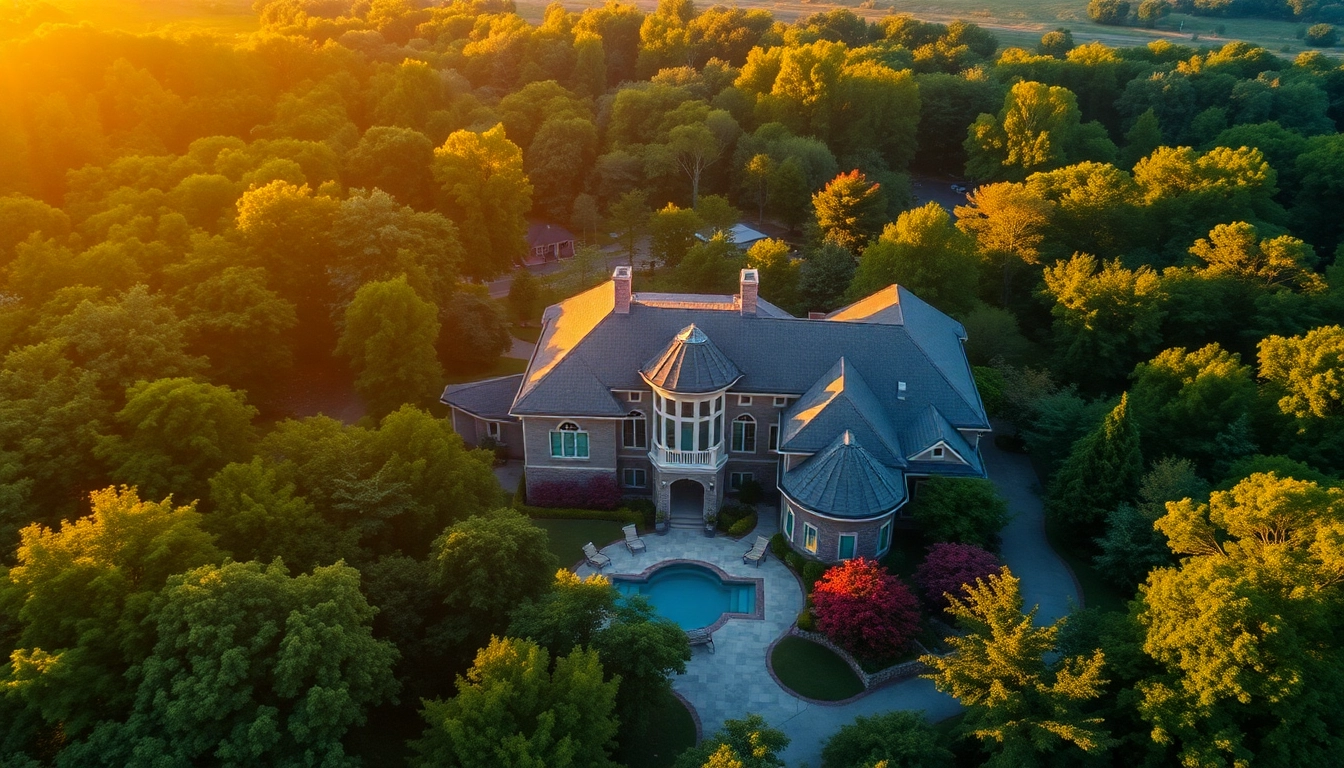
In the competitive world of real estate, standing out from the crowd is crucial. One innovative way to elevate your property listings is through real estate aerial photography. This method not only offers stunning visual perspectives but can also significantly enhance the appeal of properties in a saturated market. In this article, we will delve into the nuances of aerial photography, its benefits, the equipment required, techniques for capturing breathtaking images, marketing integration strategies, and methods to measure success.
Understanding Real Estate Aerial Photography
What is Real Estate Aerial Photography?
Real estate aerial photography involves capturing images and videos from an elevated perspective, typically using drones or aircraft. This technique provides a comprehensive view of properties, showcasing their size, layout, and surrounding environment. The perspective offered by aerial photography can highlight features that are often missed at ground level, such as proximity to parks, bodies of water, or attractive neighborhood features. These aerial shots can be invaluable for agents, buyers, and sellers looking to make informed decisions.
Benefits of Aerial Photography in Real Estate
The benefits of incorporating aerial photography into your real estate marketing strategy are numerous:
- Enhanced Listings: Properties presented with aerial images stand out in listing services while capturing more attention from potential buyers.
- Comprehensive Views: Aerial photography reveals the full scale of a property, allowing viewers to appreciate its layout and surrounding features.
- Marketing Edge: Utilizing aerial images helps real estate listings appear more professional and innovative, often leading to quicker sales.
- Emotional Connection: Beautiful aerial shots create an emotional appeal that resonates with buyers, helping them envision life in the home.
Common Techniques Used in Aerial Shots
To achieve stunning aerial photographs, several techniques are often employed:
- Bird’s Eye View: This technique captures the property from directly above, providing a unique perspective of the entire premises.
- Oblique Shots: A slight angle provides depth and interest, showcasing both the property and its environment.
- Panoramas: Capturing a wide-angle view can showcase surrounding amenities and establish a sense of the neighborhood.
- Low-Level Capture: Coming closer to the ground can create intimacy while emphasizing specific property features.
Choosing the Right Equipment
Camera and Drone Options for Aerial Photography
Selecting the right equipment is fundamental for achieving high-quality aerial photographs. Here are some camera and drone options:
- Drones: Popular choices include the DJI Phantom series and Mavic series, known for their stability, camera quality, and ease of use. These drones offer 4K camera capabilities, which significantly enhance image clarity.
- Cameras: For more advanced options, mirrorless or DSLR cameras can provide exceptional image quality. Cameras like the Canon EOS R or Sony Alpha series can be mounted on drones with gimbals to ensure smooth shots.
Essential Accessories for Quality Images
In addition to your camera and drone, several accessories are crucial for capturing quality aerial images:
- Gimbals: These stabilizers help eliminate shakes and produce smooth video footage and clear images during flight.
- ND Filters: Neutral density filters are essential in bright conditions, allowing for better exposure control and improved image quality.
- Extra Batteries: A spare battery extends your shooting time, permitting more opportunities for capturing that perfect shot.
- Transport Cases: Protect your equipment from damage with durable cases for transport to and from shoot locations.
Safety Guidelines for Aerial Photography
Safety is paramount when conducting aerial photography. Adhering to the following guidelines ensures a safe and productive shooting experience:
- Know the Laws: Familiarize yourself with local regulations regarding drone usage, including no-fly zones.
- Weather Conditions: Check weather forecasts to avoid flying in poor weather that may cause loss of control.
- Maintain Line of Sight: Always keep your drone within your visual range to ensure safe navigation.
- Respect Privacy: Obtain necessary permissions when photographing private properties and be respectful of surrounding residential areas.
Best Practices for Capturing Stunning Aerial Shots
Timing and Lighting Considerations
The timing of your shoot can greatly impact the quality of your aerial images. Consider the following when planning a shoot:
- Golden Hour: Shooting during the golden hour, shortly after sunrise or before sunset, provides soft, diffused light that enhances colors and minimizes harsh shadows.
- Overcast Days: Cloudy skies can create even lighting, reducing the risk of harsh contrasts and providing a flattering light for properties.
Composition Techniques for Aerial Photography
Effective composition is vital in creating captivating aerial images. Employ these techniques to improve your shots:
- Leading Lines: Use natural lines in the landscape to lead the viewer’s eye towards the property.
- Rule of Thirds: Position key elements, such as the main structure, along the lines of the rule of thirds to create a balanced and engaging photograph.
- Foreground Elements: Including elements in the foreground can create depth and context in your images.
Post-Processing Tips to Enhance Your Images
Post-processing is essential for achieving the best results from your aerial photography. Utilize the following tips:
- Edit for Clarity: Use software like Adobe Lightroom or Photoshop to enhance sharpness and color saturation.
- Remove Distractions: Edit out elements that detract from the main focus of your image.
- Adjust Exposure: Fine-tune exposure settings to ensure your images are neither too dark nor too bright.
Incorporating Aerial Photography into Your Marketing
Ways to Use Aerial Images in Listings
Utilizing aerial images effectively can capture buyer attention and provide informative context. Here are ways to incorporate these images:
- Hero Images: Use a striking aerial shot as the hero image in listings to draw in potential buyers.
- Virtual Tours: Combine aerial imagery with traditional walkthroughs to create comprehensive virtual tours.
- Neighborhood Highlights: Showcase surrounding areas in your listings to help buyers appreciate the community.
Social Media Strategies for Aerial Photography
Social media is a powerful tool for sharing aerial photography. Consider these strategies:
- Engaging Videos: Create short videos featuring aerial footage to engage followers and attract interactions.
- Instagram Stories: Use stories to showcase before-and-after images or share behind-the-scenes content about your aerial shoots.
- Hashtag Use: Utilize relevant hashtags to increase your content’s visibility on social platforms.
Building an Eye-Catching Portfolio
A strong portfolio is essential for attracting potential clients. Ensure yours includes:
- Diverse Shots: Showcase a variety of images that emphasize your range and capabilities.
- Before and After: Include images that highlight your ability to enhance properties through aerial photography.
- Client Testimonials: Highlight success stories that demonstrate the impact of your photography on sales and conversions.
Measuring Success and ROI
Metrics to Track the Impact of Aerial Photography
To determine the effectiveness of your aerial photography, track the following metrics:
- Engagement Rates: Monitor likes, comments, and shares on social media posts featuring aerial images.
- Leads Generated: Calculate the number of inquiries and leads generated from listings that utilize aerial imagery.
- Time on Market: Analyze the average time properties utilize aerial photography in comparison to those that do not.
Case Studies of Successful Listings
Examining successful case studies can provide valuable insights into the benefits of aerial photography:
- Case Study 1: A luxury property in a coastal area utilized stunning aerial imagery, resulting in a 30% increase in inquiries and a sale within two weeks.
- Case Study 2: A real estate agency incorporated aerial shots of community amenities, significantly improving engagement on their listings and leading to multiple offers.
Continuous Improvement in Your Photography Strategy
To maximize the benefits of aerial photography, adopt a strategy of continuous improvement by:
- Seeking Feedback: Regularly gather feedback from clients and colleagues to identify areas for enhancement.
- Staying Updated on Trends: Keep abreast of industry trends and ongoing technology developments.
- Experimenting with Techniques: Try different techniques and compositions to discover what resonates best with your audience.







